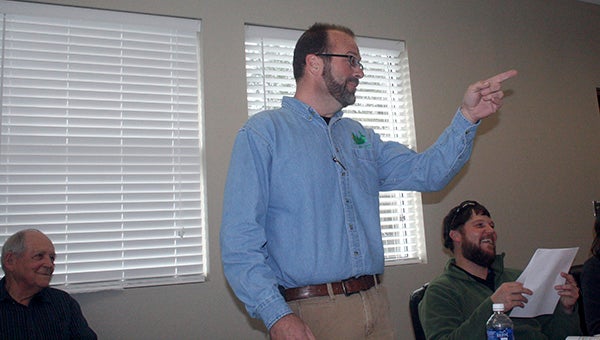Hide-A-Way Lake residents, manager, address possible rate change
Published 7:00 am Friday, January 22, 2016

POINTING THE FINGER: Hide-A-Way Lake General Manager teases one of the Pearl River County Utility Authority engineers in a light hearted manner. He and residents of the gated community attended Thursday’s meeting to address concerns about possible rate and usage changes.
Photo by Jeremy Pittari
Residents and the general manager of Hide-A-Way-Lake spoke to the members of the Pearl River County Utility Authority Board of Trustees during their Thursday afternoon meeting.
The topics they wanted to discuss involved the proposed rate increase and usage decrease. HAWL General Manager Bruce Devillier said that while on the face of the matter the proposed rate increase would be 23 percent, when the usage reduction from 4,000 gallons to 3,000 gallons was factored in, the increase could actually be closer to 39 percent.
“It’s going to hurt us financially as well,” Devillier said.
Devillier said he has been a supporter of the Utility Authority’s efforts, especially the work conducted within the gated community to install a central sewage collection system, but is concerned how the rate changes will affect residents. Under the current proposal, Devillier estimates the Utility Authority would be collecting between $80,000 and $90,000 more per year just from HAWL residents if the changes are approved.
Instead of implementing the full rate change, Devillier proposed a step method of adjusting rates and leaving the minimum usage at 4,000 gallons instead of decreasing it to 3,000 gallons.
“Our biggest concern is the impact all at one time,” he said.
Devillier then asked if a public hearing date has been set concerning the matter. Board President Sonny Sones said the board intends to set a date this week, which will be publicized in local media outlets. Sones is certain the public hearing will take place before their Feb. 18 meeting.
Utility Authority Executive Director Ray Scott said the rate and usage adjustments are being proposed to ensure the long-term functionality of every system installed since regional utility authorities were established by former Mississippi Governor Haley Barbour after Hurricane Katrina. The local board’s goal is to set aside funds to ensure repairs are conducted regularly to keep up with the wear and tear the systems suffer, new and old.
The Pearl River County Utility Authority invested about $6 million to install a sewage collection system in HAWL, and their rate increase has been carefully calculated to reflect the direct cost of running and maintaining it, Scott said.
Sones said the board employed an outside agency to conduct a study on their current rate structure, who presented the board with several options. Sones said the one they chose ultimately has the least amount of impact on customers.
The board also has the option to take no action on the matter, but Sones said that route would lead to a worse financial situation in the future, which he wants to avoid.
The discussion ended cordially, with residents and Devillier shaking hands with board members.
Scott then took a few minutes to update the board on the utility authority’s current financial situation. Overall, the budget is on target, with repairs and maintenance, electricity and volume coming into the plants all down.
Scott attributed the decrease in electricity billing to the rate decrease by Mississippi Power, combined with a reduction in volume coming into the Picayune and Poplarville waste water treatment plants.
Utility Authority Engineer Vernon Moore gave the board an update on the waste water line rehabilitation project. He said of the seven basins they originally planned to rehabilitate through the project, it appears as though they will have enough funding and time to complete five. Most, if not all, of that work is expected to come in at or below the total budget of $6 million. So if funding is still there, consideration may be made to look at the other two basins, but right now Moore estimates that to be able to rehabilitate all seven would cost about $8 million.
The deadline to complete the project is Dec. 5, 2016.



